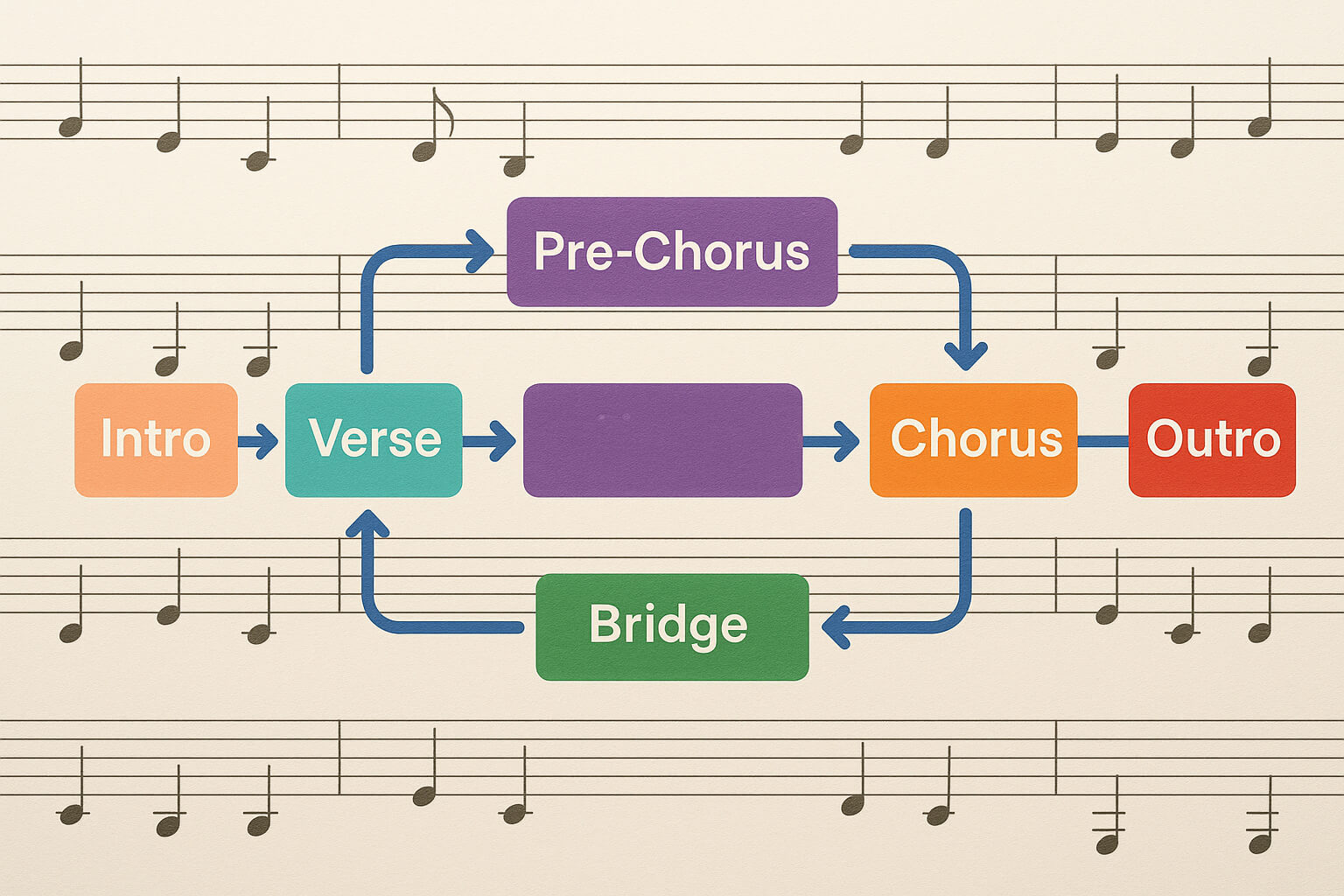August 10, 2025

A guide for songwriters, producers, and curious listeners alike
Whether you're writing your first song or trying to figure out why that chart-topper keeps looping in your head, understanding song structure is key. It’s the underlying framework that gives a track emotional shape, builds momentum, and makes the listening experience satisfying.
Let’s dive into the essential components of a song, with examples, tips, and songwriter wisdom to help you recognize and use them creatively.
The intro is your song’s handshake. It sets the mood, tempo, key, and often includes a motif that hints at what’s to come. Some intros are long and atmospheric (think: Pink Floyd), while others are short and punchy (like The Beatles’ “I Saw Her Standing There”).
A strong intro draws listeners in without giving away the whole song—like the suspenseful build in Adele’s “Rolling in the Deep.”
See how intros influence listener retention → Soundtrap
Pro tip: Use a repeated hook, rhythm, or tonal color from the chorus so your intro feels connected to the rest of the song.
The verse is the narrative engine. It carries the lyrics, builds emotional stakes, and typically introduces new lyrical content while reusing the same melody.
In Bob Dylan’s “Like a Rolling Stone,” each verse expands the emotional and social commentary, escalating the impact.
Billie Eilish’s "Ocean Eyes" is another example, where verses paint a haunting emotional picture.
➤ Explore how verse structure supports lyrical storytelling → Songtrust
Structure tip: While the lyrics change, maintaining the same melody across verses creates cohesion.
Not every song has one, but a well-placed pre-chorus adds energy, sets up the hook, and transitions smoothly from verse to chorus. It often uses a different chord progression or rhythm to create lift.
Listen to Katy Perry’s “Firework” — the pre-chorus (“You just gotta ignite...”) builds dynamic and lyrical tension that explodes in the chorus.
Learn how the pre-chorus bridges momentum → BBC Maestro
Creative use: Try introducing new harmonies or shortening phrase lengths to make the chorus feel bigger by contrast.
The chorus is the heart of the song. It’s repetitive, memorable, and usually contains the main lyrical hook. If someone remembers your song, they’re probably humming the chorus.
Think of the belted line “Let it go!” in Frozen’s anthem, or the repeated “Stayin’ alive” in the Bee Gees’ classic.
Master the anatomy of a great chorus → MasterClass
Deep dive into common chorus forms → Wikipedia
Tip: Craft your chorus around your emotional message, and make sure it’s rhythmically or melodically distinct from your verses.
A refrain is a line or phrase that recurs, often at the end of a verse, but not necessarily with the same impact as a full chorus. It's a kind of lyrical anchor.
Example: In Bob Dylan’s “Blowin’ in the Wind,” the line “The answer, my friend, is blowin’ in the wind” is a refrain.
See how refrains add lyrical continuity → Songtrust
Insight: Use a refrain if your song is more narrative-driven and you want a lighter, poetic form of repetition.
The bridge provides contrast. It might shift to a new chord progression, change keys, or introduce a different rhythm. Its role is to break the cycle of verse/chorus and add new emotional color.
Beyoncé’s “Halo” uses the bridge to reflect vulnerability, creating a beautiful moment of tension before returning to the powerful chorus.
See how bridges energize structure → DJ Looper
Bridge (music) overview → Wikipedia
Songwriter trick: Write the bridge last. Let your verse/chorus tell you what “surprise” your song still needs.
This section gives space for instrumental expression. From shredding guitar solos to chilled synth loops, it can be a sonic breather or an emotional peak.
Famous example: Prince’s guitar solo in “Purple Rain”—pure emotion without a single word.
Explore when and why to use instrumentals → Careers in Music
The outro closes the song—whether with a fade-out, a repeated phrase, or a bold final chord. It’s your last chance to leave an impression.
From the looping outro in The Beatles’ “Hey Jude” to the abrupt end of Radiohead’s “Creep,” the outro defines how a listener feels when it’s over.
Craft engaging endings → zZounds Blog
Whether you're a songwriter, music producer, or just a passionate listener, knowing song structure gives you:
Song structure is the silent skeleton behind every hit. Master it, and you can bring clarity and momentum to your own music.
Stay up to date with the latest tips, expert insights, product reviews, and step-by-step guides to help you grow, create, and succeed—no matter your industry or passion.